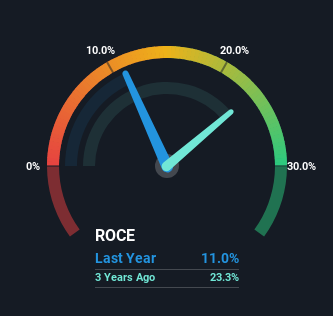Qwamplify (EPA:ALQWA) Shareholders Will Want The ROCE Trajectory To Continue
If you're not sure where to start when looking for the next multi-bagger, there are a few key trends you should keep an eye out for. Ideally, a business will show two trends; firstly a growing return on capital employed (ROCE) and secondly, an increasing amount of capital employed. If you see this, it typically means it's a company with a great business model and plenty of profitable reinvestment opportunities. Speaking of which, we noticed some great changes in Qwamplify's (EPA:ALQWA) returns on capital, so let's have a look.
What Is Return On Capital Employed (ROCE)?
If you haven't worked with ROCE before, it measures the 'return' (pre-tax profit) a company generates from capital employed in its business. The formula for this calculation on Qwamplify is:
Return on Capital Employed = Earnings Before Interest and Tax (EBIT) ÷ (Total Assets - Current Liabilities)
0.11 = €2.9m ÷ (€54m - €27m) (Based on the trailing twelve months to March 2024).
So, Qwamplify has an ROCE of 11%. In absolute terms, that's a pretty normal return, and it's somewhat close to the Media industry average of 12%.
Check out our latest analysis for Qwamplify

Historical performance is a great place to start when researching a stock so above you can see the gauge for Qwamplify's ROCE against it's prior returns. If you're interested in investigating Qwamplify's past further, check out this free graph covering Qwamplify's past earnings, revenue and cash flow.
So How Is Qwamplify's ROCE Trending?
Qwamplify is showing promise given that its ROCE is trending up and to the right. The figures show that over the last five years, ROCE has grown 52% whilst employing roughly the same amount of capital. Basically the business is generating higher returns from the same amount of capital and that is proof that there are improvements in the company's efficiencies. The company is doing well in that sense, and it's worth investigating what the management team has planned for long term growth prospects.
On a separate but related note, it's important to know that Qwamplify has a current liabilities to total assets ratio of 51%, which we'd consider pretty high. This can bring about some risks because the company is basically operating with a rather large reliance on its suppliers or other sorts of short-term creditors. Ideally we'd like to see this reduce as that would mean fewer obligations bearing risks.
The Key Takeaway
To sum it up, Qwamplify is collecting higher returns from the same amount of capital, and that's impressive. Astute investors may have an opportunity here because the stock has declined 59% in the last five years. So researching this company further and determining whether or not these trends will continue seems justified.
One more thing, we've spotted 3 warning signs facing Qwamplify that you might find interesting.
While Qwamplify may not currently earn the highest returns, we've compiled a list of companies that currently earn more than 25% return on equity. Check out this free list here.
Valuation is complex, but we're here to simplify it.
Discover if Qwamplify might be undervalued or overvalued with our detailed analysis, featuring fair value estimates, potential risks, dividends, insider trades, and its financial condition.
Access Free AnalysisHave feedback on this article? Concerned about the content? Get in touch with us directly. Alternatively, email editorial-team (at) simplywallst.com.
This article by Simply Wall St is general in nature. We provide commentary based on historical data and analyst forecasts only using an unbiased methodology and our articles are not intended to be financial advice. It does not constitute a recommendation to buy or sell any stock, and does not take account of your objectives, or your financial situation. We aim to bring you long-term focused analysis driven by fundamental data. Note that our analysis may not factor in the latest price-sensitive company announcements or qualitative material. Simply Wall St has no position in any stocks mentioned.
About ENXTPA:ALQWA
Qwamplify
Engages in the provision of digital and data marketing solutions in France.
Flawless balance sheet and good value.
Market Insights
Community Narratives



